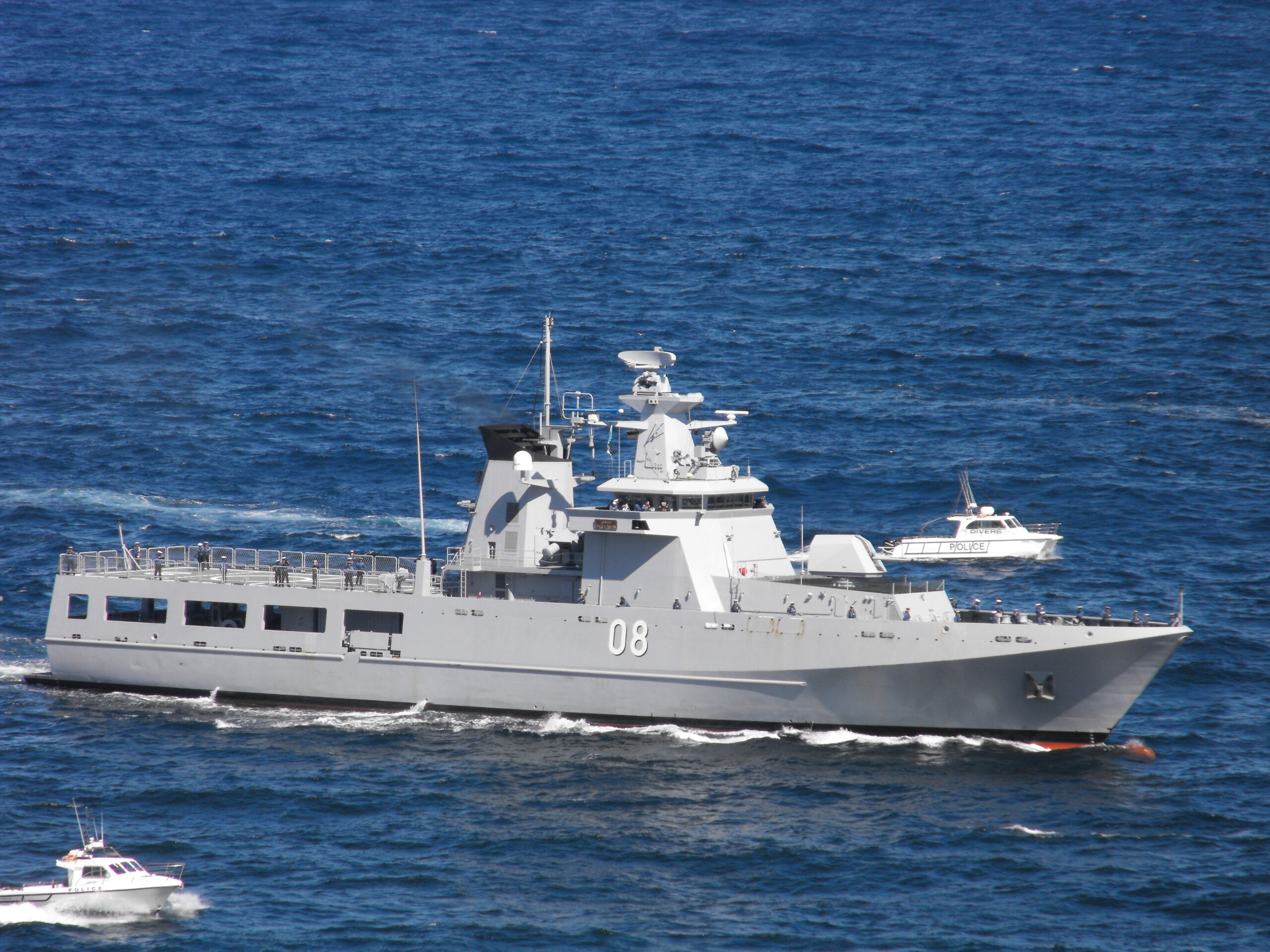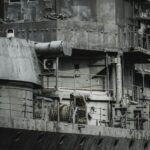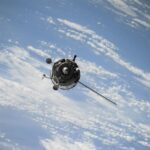The Royal Australian Navy has added a new hull to its order of battle. On 28 June the service commissioned HMAS Arafura, first of the Arafura-class offshore patrol vessels, during a ceremony at Fleet Base West near Fremantle. Defense officials confirm the ship is now on the active list under pennant 203 and ready to start work while post-commissioning trials continue.
Arafura is the initial product of Project SEA 1180 Phase 1. Industry sources note that Luerssen Australia performed final assembly at Osborne, South Australia, with Civmec fabricating the hull blocks and providing structural integration. The design traces its lineage to the German OPV80 but includes local changes to suit Australia’s vast maritime zone and high-temperature operating profile.
Royal Australian Navy Offshore Patrol Vessel Program Under Project SEA 1180
Our analysis shows the ship brings a bigger hull, longer legs, and more mission space than the Armidale-class patrol boats it eventually replaces. At 1,640 tonnes and 80 meters in length the vessel offers enough internal volume for modular payloads without burdening the combatant fleet.
General information:
- Displacement: 1,640 t
- Length: 80 m; Beam: 13 m; Draft: 4 m
- Propulsion: 2 × 4,250 kW diesels, variable-pitch props
- Speed: 20 kt; Range: 4,000 nm at economic speed
- Crew: 40 core, berths for 20 mission specialists
- Boats: one 10.5 m stern-launched RHIB, two 8.5 m crane-launched RHIBs
- Armament: one 25 mm stabilized cannon, two 0.50-cal machine-guns
- Mission deck: container interfaces for UAV control cells, disaster-relief stores, or mine-counter-measure modules
The commissioning ceremony drew government ministers, senior brass, and Ngunnawal Elders for a Welcome to Country. Deputy Prime Minister Richard Marles told attendees the ship “locks in a new rhythm for surface-fleet renewal” while Chief of Navy Vice Admiral Mark Hammond stressed the platform’s role in routine presence, surveillance, and uncrewed-system experimentation.
Crew training began months before delivery. The ship’s company finished bridge-team trainers at HMAS Watson and live-boat handling in Cockburn Sound. The navy’s Fleet Operational Sea Training program will ride the vessel later this year to certify it for independence.
HMAS Arafura Training and Integration into Fleet Operations
Personnel feedback highlights improved berthing, a quiet machinery plant, and larger galley spaces – features aimed at retention in a tight labor market.
Arafura now enters a shakedown window that runs to late 2026. Planners intend to send the ship north into the Torres Strait for maritime-border patrols and to the Coral Sea for fisheries enforcement. The new hull frees an Anzac-class frigate that has been covering these constabulary beats while the OPV program caught up.
The broader class plan calls for six ships – down from the original 12 – split between Osborne (ships 1-2) and Henderson, Western Australia (ships 3-6). NUSHIP Eyre already sits alongside at Stirling pending acceptance, while blocks for the third unit, HMAS Pilbara, are on the ring-crane at Henderson. Defense officials expect the last ship, HMAS Carpentaria, in late 2028.
Budget scrutiny remains intense. Parliament’s Joint Committee of Public Accounts and Audit flagged cumulative program real growth of 28 percent against the 2018 out-turn baseline, largely tied to schedule drag and inflation in steel plate and specialist labor. This comes amid broader parliamentary scrutiny of major naval programs, with lawmakers investigating delays and governance issues in other surface combatant projects. The Independent Analysis of Navy’s Surface Combatant Fleet nevertheless kept the OPV line intact, arguing that patrol craft allow high-end combatants to focus on deterrence rather than peacetime presence.
From an industrial standpoint, the program enters a new phase. Civmec has moved to acquire Luerssen Australia from NVL Group in a deal worth roughly A$20 million. According to industry filings, the takeover secures intellectual-property rights, workforce, and tooling, ensuring sovereign control of sustainment as the fleet matures.
Civmec Acquisition Secures Sovereign Control of OPV Sustainment
Sustainment planning sits with Arafura Sustainment Enterprise – a consortium of Babcock Australasia, Luerssen (transitioning to Civmec), and the Capability Acquisition and Sustainment Group. Babcock recently completed an intermediate maintenance period on the lead ship under a performance-based contract that pays against availability metrics rather than labor hours.
Operationally, the OPV brings long endurance but limited armament. Navy tacticians see the class as a sensor-and-boat mother-ship, not a gun platform. The mission deck’s ISO locks can take a containerized mine-counter-measure module, hydrographic survey kit, or an autonomous aerial-surveillance cell. Similar modular concepts are being explored in next-generation combat boats for other navies. The design leaves growth margin in electrical power and top-weight so that future energy weapons or directed-infrared dazzlers could fit without hull changes.
The bridge integrates Saab’s 9LV combat-management system in a cut-down patrol configuration with Maritime 21 consoles. This approach keeps software common with the Anzac upgrade while trimming the radar fit to a single CEAFAR 2D array, a Furuno navigation radar, and a Sagem electro-optical director.
Command and Sensor Suite of HMAS Arafura
Command and Control Division meanwhile is trialing a lightweight data-fusion node that passes unclassified situational awareness direct to federal agencies such as the Australian Border Force and Parks Australia. It rides on a separate virtualized blade inside the same rack stack as 9LV, minimizing footprint.
For the crew the biggest gain is habitability. Cabins are two-berth, each with ensuite heads. Mess areas carry broadband Wi-Fi linked through the Defense Strategic Communications Network, allowing real-time welfare calls. The HVAC plant meets World Health Organization indoor-air quality guidance, and shell-side insulation cuts machinery noise below 60 dB(A) in sleeping spaces.
The ship’s diesel duo draws on MTU common-rail engines optimized for part-load fuel burn. During Pacific patrols a 12-knot transit uses about 7 m³ per day, giving the hull three-week endurance even without a tanker. Biofuel blends up to B30 cleared certification earlier this year, further cutting lifecycle emissions.
Future joint exercises beckon. Navy planners already penciled Arafura into Exercise Kakadu 2025 and a trilateral patrol with Indonesia and Timor-Leste. These deployments align with similar regional initiatives such as Singapore’s new littoral mission vessels, which also focus on patrol, surveillance, and maritime security in contested waters. The vessel’s shallow draft lets it operate close to archipelagic choke points, improving detection of illegal fishing and small-boat trafficking networks that slip past larger hulls.
The modular deck offers extra upside. Defense Science and Technology Group is fitting a containerized towed-array system next year to map acoustic baselines off Australia’s northern approaches.
Future Modular Payloads and Uncrewed System Trials
Data will feed the SEA 5014 undersea-surveillance project.
On the workforce front, the Arafura class supports Navy’s Plan Servare graduate-entry scheme. Trainees spend six months on OPVs before moving to frigates, giving them practical watch-keeping hours without the complexity of air-search radars and anti-ship missiles. Command billets also widen; four new lieutenants-commanders will take up sea command by 2027, easing a promotion bottleneck.
Economically, ship construction and through-life support sustain about 700 direct jobs across Osborne and Henderson and more than 1,500 across the wider supply chain. Civmec projects that local content will hit 63 percent by the third ship as more sub-assemblies migrate to Western Australia.
Yet challenges persist. The program still contends with software integration risks and a tight national welding workforce. A recent Australian National Audit Office briefing pointed to earlier procurement schedule compression as a root cause of delays. Lessons learned include wider use of digital twins to catch engineering clashes before block erection.
Strategically, the Indo-Pacific remains fluid. Chinese maritime-militia activity in the South China Sea, complex grey-zone operations in the Solomon Islands, and soaring illegal fishing in the Coral Triangle all drive demand for sustained patrol presence. Arafura’s seakeeping and C2 fit make it a pragmatic answer without tying up Hobart-class destroyers or Anzac-class frigates for constabulary duty.
Looking outward, regional partners monitor Australia’s approach. New Zealand, the Philippines, and Fiji have already sent delegations to study the ship’s mission-deck concept.
Regional Interest in Arafura-Class OPV Export Potential
Luerssen, once the deal with Civmec closes, plans to bundle the design for export with local build licensing, eyeing Southeast Asia and the Gulf.
In the near term Arafura will settle into baseline tasks:
- Operation Resolute coastal security sorties
- Fisheries patrols with the Australian Fisheries Management Authority
- Humanitarian assistance standby during cyclone season
- Uncrewed-surface-vessel trials under the Navy Remote and Autonomous Systems Implementation Plan
Each role fits the vessel’s endurance and modular payload scheme while keeping crew tempo moderate.
The ship now faces its first maintenance window at Henderson in February 2026. Data from that docking will inform the optimized availability cycle, targeting 140 operational days per year. If metrics hold, the class could free at least 1,500 frigate-sea days annually for higher-end deterrence.
From a capability perspective, commissioning Arafura is a small step, yet within the larger Surface Fleet Review it marks a shift. The commissioning ceremony of HMAS Arafura highlighted the vessel’s importance as the lead ship of its class and underscored its role in shaping Australia’s future patrol capability. The navy moves toward a tiered force: high-end combatants, medium-endurance patrol ships, and autonomous systems united by common software and shared logistics.
Tiered Naval Capability Model and Role of Offshore Patrol Vessels
Industry sources judge the OPV a bellwether for continuous build. A clean delivery record for ships 3-6 will strengthen the case for a rolling offshore-patrol production line that dovetails into the mooted littoral-manoeuvre vessel project late in the decade.
In sum, HMAS Arafura sets a new baseline for patrol capability, workforce sustainability, and sovereign industry build. The real test begins now as the vessel leaves the pier and starts writing sea days into the navy’s logbook.
REFERENCE SOURCES
- https://www.naval-technology.com/news/babcock-australasia-arafura-opv-maintenance/
- https://www.minister.defence.gov.au/media-releases/2025-06-28/navy-introduces-new-capability-commissioning-hmas-arafura
- https://www.navalnews.com/naval-news/2025/06/royal-australian-navy-commissions-new-opv-hmas-arafura/
- https://www.janes.com/osint-insights/defence-news/sea/australia-commissions-first-arafura-class-opv
- https://www.navy.gov.au/capabilities/ships-boats-and-submarines/arafura-class-offshore-patrol-vessel
- https://armyrecognition.com/news/navy-news/2025/australia-modernizes-naval-forces-with-commissioning-of-hmas-arafura-offshore-patrol-vessel
- https://www.contactairlandandsea.com/2025/06/29/hmas-arafura-finally-commissioned/
- https://www.navaltoday.com/2025/06/27/civmec-to-buy-luerssen-australia/



